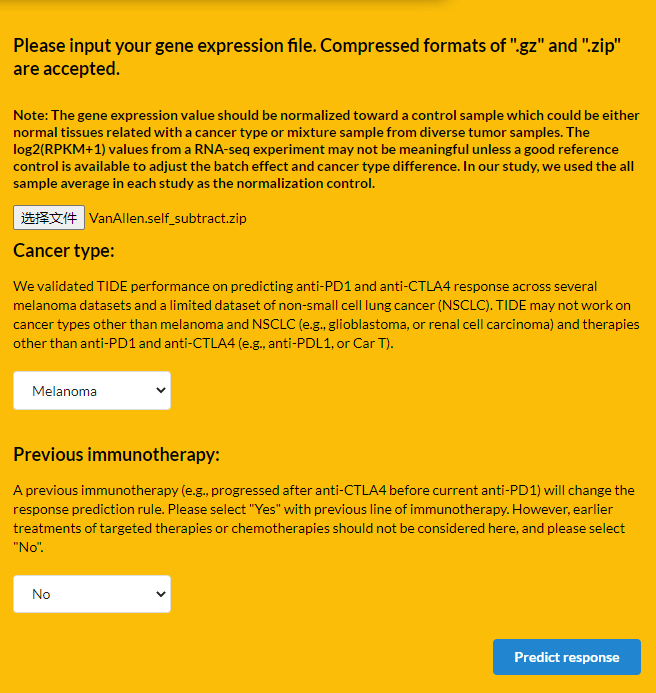最近很多人借TIDE账号,也有人问我如何进行数据标准化,按照网站说明,对于没有Control样本的测序数据,把表达量减去每个基因在所有样本中的平均值即可,即按照行计算平均值,再拿这一行所有表达量-该平均值。

#读取数据
Expr <- read.delim("TIDE_COAD.txt",sep = "\t",row.names = 1)
#使用apply函数
Expr <- t(apply(Expr, 1, function(x)x-(mean(x))))
一句代码就得到标准化矩阵
测试代码:
ma <- matrix(c(1:4, 1, 6:8), nrow = 2)
ma
# [,1] [,2] [,3] [,4]
#[1,] 1 3 1 7
#[2,] 2 4 6 8
apply(ma, 2, function(x)x-(mean(x))) ##按列计算
# [,1] [,2] [,3] [,4]
#[1,] -0.5 -0.5 -2.5 -0.5
#[2,] 0.5 0.5 2.5 0.5
apply(ma, 1, function(x)x-(mean(x))) ##按行计算
# [,1] [,2]
#[1,] -2 -3
#[2,] 0 -1
#[3,] -2 1
#[4,] 4 3
转置一下即可:
t(apply(ma, 1, function(x)x-(mean(x))))
# [,1] [,2] [,3] [,4]
#[1,] -2 0 -2 4
#[2,] -3 -1 1 3apply函数参数帮助。
apply(X, MARGIN, FUN, …)
Arguments
X
an array, including a matrix.
MARGIN
a vector giving the subscripts which the function will be applied over. E.g., for a matrix 1 indicates rows, 2 indicates columns, c(1, 2) indicates rows and columns. Where X has named dimnames, it can be a character vector selecting dimension names.
FUN
the function to be applied: see ‘Details’. In the case of functions like +, %*%, etc., the function name must be backquoted or quoted.
…
optional arguments to FUN.
老师,上传的数据单纯癌组织的,还是癌组织和癌旁组织都要啊
你好,你看一下数据前处理说明,当然是肿瘤数据,正常数据没有分析必要,数据前处理中有一种就是对于含有正常样本的情况,所有表达量减去该基因在正常组织中的表达平均值
Название Преимущества Минусы Ценовая категория Albatros Высокое европейское качество https://ceramicaflaminia.ru/vanny
Красивый современный дизайн https://ceramicaflaminia.ru/ekologiya
Отсутствие бесполезных и ненужных опций https://ceramicaflaminia.ru/konzept
Отличная цена для предлагаемых характеристик https://ceramicaflaminia.ru/akvaline
Малое количество доступных размеров https://ceramicaflaminia.ru/box
Нерегулярные поставки в Россию https://ceramicaflaminia.ru/quick
От 83 000 руб https://ceramicaflaminia.ru/dizajnery
Накладная раковина Disegno Ceramica Box 80?38 https://ceramicaflaminia.ru/dushevye-poddony
Итальянская мебель для ванной комнаты традиционно отличается изысканным дизайном, вне зависимости от того, в современном она стиле или в классическом https://ceramicaflaminia.ru/noke
Artistica Bagno (8)
Представлен в салоне https://ceramicaflaminia.ru/quick
Любители лаконичных форм отдадут предпочтение строгим линиям в духе хай-тек от Bonomi, а те, кому по душе очарование старой доброй Англии, выберут смеситель для ванной из патинированной меди от Nicolazzi https://ceramicaflaminia.ru/water-drop
В продаже имеются встроенные и отдельно стоящие раковины с постаментом изысканных форм от популярных итальянских брендов https://ceramicaflaminia.ru/evergreen
К каждой модели мы поможем подобрать подходящий смеситель – итальянская сантехника в Москве встречается далеко не во всех салонах https://ceramicaflaminia.ru/play
你好,我也是表达数据必须用TAB分隔,可我使用的是write.table,sep=”\t”,还是不行,能加您的微信处理下吗?
Переезды https://gruzchik-profi.ru/upakovka
Заказ газели с грузчиками станет отличным выбором для доставки груза или перемещения на новое место https://gruzchik-profi.ru/takelajnieuslugi
Данная услуга позволяет с минимум затрат организовать сезонный перезд на дачу или частный дом https://gruzchik-profi.ru/
Подъем холодильника на этаж https://gruzchik-profi.ru/pereezdsklada
Честная работа по честной цене https://gruzchik-profi.ru/vyvozmusora
Заказать оценку переезда или разгрузки
Перевозка длинных досок и труб https://gruzchik-profi.ru/
Транспорт для перевозки груза или переезда https://gruzchik-profi.ru/
进哥,我想请问一下,为什么我在TIDE分析出现的MSI Expr Sig这个结果,我看有的人得到的MSI score怎么样才能得到呢
他的参考矩阵数值特别小,应该是使用的log2(RPKM+1) 类数据,然后进行标准化的。不过是否log好像只影响基因的差异倍数,不影响TIDE评分结果。
几点使用:
1,input准备:用wps将数据转换为 txt就行了;用哪个文本文件,制表符分隔的。
2,如果input文件格式出错,则会显示报错,网页不能运行。
3,可以用 b<-sweep(ma,1, apply(ma,1,mean,na.rm=T)) 来平均
嘿嘿嘿!
哥,我是用的原始COUNT数据,经过VST标准化的数据,分析时报错了,提示我:“The majority(>80%) of genes with positive expression in your inputted data. Please Normalize your data”,这个需要怎么处理啊?
log转换一下吧,值太高了
进哥你好,我也是制表符的问题,之前用了其他数据集都很快就出结果了,不知道为啥老是出现制表符的问题
你好,加我微信发我数据看看 数据的问题
那是必须的
可以请老师看一下我的tide输入文件格式吗?要求制表符 我的文件好像是制表符呀?谢谢!
好的,加微信看看
啊,大神,我的txt明明是用制表符分割的,为什么上传显示需要用制表符呢,可以帮忙看看吗?感谢!
可以加我微信。发我看看
请问这个制表符有关的报错是怎么解决的呢
解决了吗?我刚刚看见
还没解决的话加微信我看看文件
> Expr <- t(apply(tumor, 1, function(x)x-(mean(x))))
Error in apply(tumor, 1, function(x) x – (mean(x))) :
dim(X)的值必需是正数 为什么他会说dim(x)必须是正数
解决可了,没有更换名称
棒!
请问输入文件需要是什么格式呢?谢谢!
不需要什么特别格式,就是基因表达矩阵,列是样本,行是基因
你好,我想问一下输入数据是只含疾病样本还有所有样本呀?
你好只需要疾病的,当然一起放进去没有关系,不影响 结果中只使用疾病的
请问可以展示一下您的数据集“TIDE_COAD.txt”的结构吗?
你好,文件里面就是基因表达矩阵,列是样本,行是基因
老师,那我想请教一下,你的TIDE_COAD.txt文件使用的是count,fpkm,还是tpm数据,fpkm是还没有进行log2转化吗?
你好,我这边用的是TPM,不需要进行log转化的,其他数据也可以,我觉得尽量使用标准化之后的数据,count可能不合适,count和FPKM可以的
请问我在输入数据之后,网站提示必须是TAB制表符文件才能识别,但是我的文件制表符没问题,请问要怎么解决
确认是制表符分割的吗?搞不定可以加我微信 我看看
你好,我也是表达数据必须用TAB分隔,可我使用的是write_delim或者sep=”\t”,还是不行,能加您的微信处理下吗?
解决了吗 还没有的话加微信吧
您好,今天又试了几次,还是没有。您微信号是多少,我加您
18021308280
进哥,请问TIDE网站是不能用了吗?我用TIDE网站,点了predict response后为啥都是Page unavailable?还是我哪儿弄错了o(╥﹏╥)o,卡好久了
能用哇 刚刚试了一下 出结果了
请问数据应该在哪里下载呢,可不可以用UCSC中TCGA-BRCA的gene expression RNAseq中的IlluminaHiSeq (n=1,218) TCGA Hub数据,它是RSEM数据
应该可以的,不要取log的数据,标准化之后上传TIDE
试试看吧 我也不是很清楚
不过TIDE上提供了计算好的TCGA数据 直接下载即可
进哥,我想问一下,这个标准化后的矩阵应该怎么输出呢?
write.csv(Expr,”路径/文件名.csv”,row.names = F)